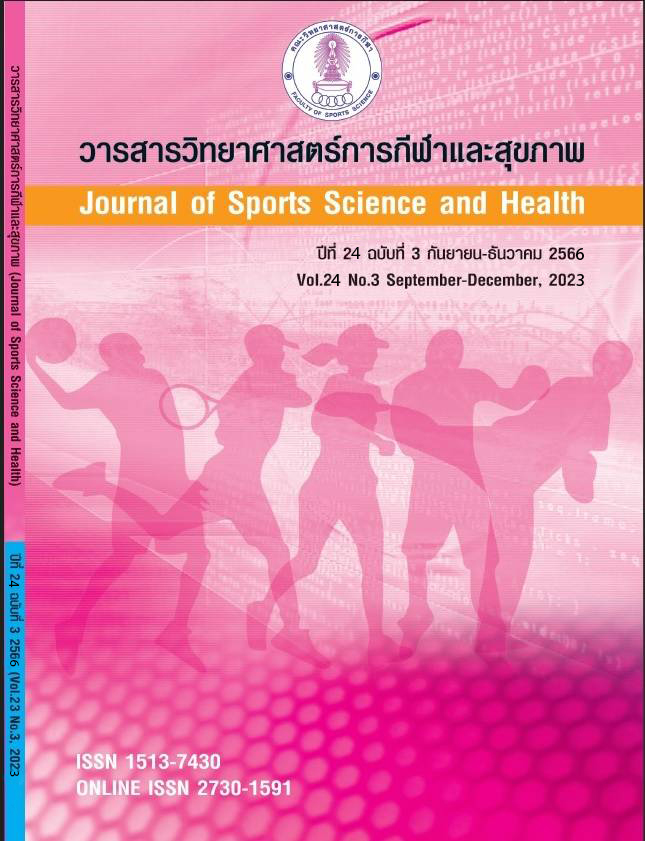ผลของการฝึกพิลาทิสบนเสื่อต่อความดันโลหิตและการทำงานของระบบหัวใจและหลอดเลือดในผู้สูงอายุที่เป็นโรคความดันโลหิตสูง
Main Article Content
บทคัดย่อ
วัตถุประสงค์
เพื่อศึกษาผลของการฝึกพิลาทิสบนเสื่อต่อความดันโลหิตและการทำงานของระบบหัวใจและหลอดเลือด สมรรถภาพทางกายที่สัมพัน์กับสุขภาพ องค์ประกอบของร่างกาย ในผู้สูงอายุที่เป็นโรคความดันโลหิตสูง
วิธีดำเนินการวิจัย
ผู้สูงอายุที่เป็นโรคความดันโลหิตสูงระดับที่ 1 อายุระหว่าง 60-75 ปี ทั้งหมด 34 คน เข้าร่วมงานวิจัย แบ่งเป็นสองกลุ่มคือ กลุ่มควบคุม ใช้ชีวิตประจำวันตามปกติ ไม่ได้รับการฝึกใด ๆ จำนวน17 คน (ชาย 5 คน และหญิง 12 คน) และ กลุ่มทดลองที่มีการฝึกออกกำลังกายพิลาทิสบนเสื่อ 60 นาที/ครั้ง 3 ครั้ง/สัปดาห์ 12 สัปดาห์ จำนวน 17 คน (ชาย 5 คน และหญิง 12 คน) ตัวแปรความดันโลหิต อัตราการเต้นของหัวใจ สมรรถภาพการทำงานของหัวใจและหลอดเลือด ได้แก่ อัตราเร็วของคลื่นความดันชีพจรระหว่างต้นแขนและข้อเท้า ความหนาของผนังหลอดเลือด ปริมาตรของเลือดที่บีบออกจากหัวใจ ความต้านทานของหลอดเลือดและความแปรปรวนของอัตราการเต้นของหัวใจ และตัวแปรด้านสมรรถภาพทางกายถูกทดสอบก่อนและหลังการทดลอง 12 สัปดาห์ จากนั้นนำค่าที่ได้มาวิเคราะห์ผลทางสถิติโดยใช้การทดสอบค่าทีแบบอิสระต่อกัน (Independent t-test) และเปรียบเทียบข้อมูลแบบรายคู่ที่สัมพันธ์กันโดยใช้การทดสอบค่าทีแบบรายคู่ (Paired t-test) ที่ระดับความมีนัยสำคัญที่ 0.05
ผลการวิจัย
หลังการทดลอง 12 สัปดาห์พบว่า กลุ่มฝึกพิลาทิสบนเสื่อมีค่าความดันโลหิต อัตราการเต้นของหัวใจมีค่าลดลง ในขณะที่สมรรถภาพการทำงานของหัวใจและหลอดเลือด ได้แก่ อัตราเร็วของคลื่นความดันชีพจรระหว่างต้นแขนและข้อเท้า ความหนาของผนังหลอดเลือด ปริมาตรของเลือดที่บีบออกจากหัวใจ ความต้านทานของหลอดเลือด และความแปรปรวนของอัตราการเต้นของหัวใจ มีค่าพัฒนาดีขึ้นอย่างมีนัยสำคัญทางสถิติ (p<0.05) นอกจากนี้ยังพบว่าสมรรถภาพทางกายและองค์ประกอบของร่างกายพัฒนาขึ้น เมื่อเปรียบเทียบกับกลุ่มควบคุมอย่างมีนัยสำคัญทางสถิติที่ระดับ 0.05
สรุปผลการวิจัย
การฝึกพิลาทิสบนเสื่อฝึกเป็นระยะเวลา 12 สัปดาห์ สามารถลดความดันโลหิต เพิ่มสมรรถภาพการทำงานของหัวใจและหลอดเลือด เพิ่มสมรรถภาพทางกาย และพัฒนาองค์ประกอบของร่างกายในผู้สูงอายุที่เป็นโรคความดันโลหิตสูง
Article Details

This work is licensed under a Creative Commons Attribution-NonCommercial-NoDerivatives 4.0 International License.
References
Chaising, S., & Temdee, P. (2020). Determining Significant Risk Factors for Preventing Elderly People with Hypertension from Cardiovascular Disease Complication Using Maximum Objective Distance. Wireless Personal Communications. 115(4), 3099-3122.
Gronek, J., Boraczyński, M., Gronek, P., Wieliński, D., Tarnas, J., Marszałek, S., & Tang, Y. Y. (2021). Exercise in Aging: Be Balanced. Aging and disease, 12(5), 1140–1149.
Guimarães, G. V., Carvalho, V. O., Bocchi, E. A., & d'Avila, V. M. (2012). Pilates in heart failure patients: a randomized controlled pilot trial. Cardiovascular therapeutics, 30(6), 351–356.
Hoseini Niya, S., Vahidian-Rezazadeh, M., & Heidari Mokarrar, H. (2019). The Effects of 8 Weeks Pilates, Walking, and Combined Pilates and Walking on Heart Arrhythmia. Zahedan Journal of Research in Medical Sciences, 22(1). e92708.
Jaruchart, T., Suwanwela, N. C., Tanaka, H., & Suksom, D. (2016). Arterial stiffness is associated with age-related differences in cerebrovascular conductance. Experimental gerontology, 73, 59–64.
Kobeissi, E., Hibino, M., Pan, H., & Aune, D. (2019). Blood pressure, hypertension and the risk of abdominal aortic aneurysms: a systematic review and meta-analysis of cohort studies. European journal of epidemiology, 34(6), 547–555.
Martins-Meneses, D. T., Antunes, H. K., de Oliveira, N. R., & Medeiros, A. (2015). Mat Pilates training reduced clinical and ambulatory blood pressure in hypertensive women using antihypertensive medications. International journal of cardiology, 179, 262–268.
Masodsai, K., Kerdkarn, P., Chaunchaiyakul, R. (2021) Exercise as an AntiHypertensive Tool: Scientific Mechanism. Journal of Sports Science and Health. 23(1), 1-21.
Masodsai, K., Lin, Y. Y., Lin, S. Y., Su, C. T., Lee, S. D., & Yang, A. L. (2021). Aging Additively Influences Insulin- and Insulin-Like Growth Factor-1-Mediated Endothelial Dysfunction and Antioxidant Deficiency in Spontaneously Hypertensive Rats. Biomedicines, 9(6), 676.
Masodsai K, Sahaschot T, Chaunchaiyakul R. (2023).Cardiorespiratory, Metabolic, and Performance Changes from the Effects of Creatine and Caffeine Supplementations in Glucose-Electrolyte-Based Sports Drinks: A Double-Blind, Placebo-Controlled Study. Sports, 11(1), 4.
Oliveira, L. C., Guedes, C. A., Jassi, F. J., Martini, F. A. N., & Oliveira, R. G. (2016). Effects of the Pilates method on variables related to functionality of a patient with traumatic spondylolisthesis at L4-L5: A case study. Journal of bodywork and movement therapies, 20(1), 123–131.
White, D. W., & Fernhall, B. (2015). Effects of Exercise on Blood Pressure and Autonomic Function and Other Hemodynamic Regulatory Factors. In L. S. Pescatello (Ed.), Effects of Exercise on Hypertension: From Cells to Physiological Systems (pp. 203-225). Springer International Publishing.

